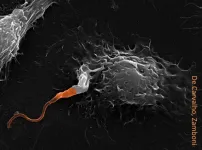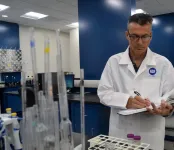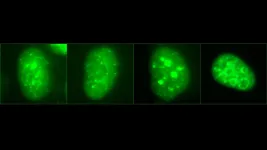(Press-News.org) Researchers have succeeded in revealing the arsenal used by protozoans of the genus Leishmania in human cells to make leishmaniasis more severe, especially in cases of the mucocutaneous variety of the disease, which can cause deformations in patients. The discovery points the way to a search for novel treatments for the disease as well as casting light on a key mechanism involved in other diseases.
The mechanism involves Leishmania, macrophages and a virus that lives endosymbiotically in the parasite and is known as the Leishmania RNA virus (LRV). According to a study published in the journal iScience, the parasite inhibits activation of caspase-11 via LRV-induced autophagy. Caspases are a family of enzymes that play essential roles in programmed cell death and the innate immune system. LRV, therefore, prevents defense cells from blocking progression of the disease.
Infectious and not contagious, leishmaniasis is considered endemic to some regions of Brazil. The mucocutaneous form of the disease, caused in the Neotropics by species such as L. guyanensis and L. braziliensis, is characterized by skin lesions that affect the mucous membranes of the nose, mouth and throat. In severe cases, it can lead to cartilage and bone erosion and cause deformations. Some 20,000 cases of tegumental leishmaniasis, which includes the cutaneous and mucocutaneous forms, are reported each year in Brazil.
The study showing how LRV blocks caspase-11 via autophagy was part of the Ph.D. research of Renan V. H. de Carvalho, with Dario Zamboni as thesis advisor. Zamboni is a professor in the Department of Cellular and Molecular Biology and Pathogenic Bioagents at the University of São Paulo's Ribeirão Preto Medical School (FMRP-USP) in Brazil.
"Using macrophages and mice, we discovered that LRV inhibits activation of caspase-11 by Leishmania, and this extends our understanding of the mechanisms used by the virus to exacerbate the disease," Zamboni said.
The study, which belongs to a series already published by the group, innovated by showing the link between caspase-11 and diseases caused by parasites. Hitherto the enzyme was thought to be involved only in diseases caused by bacteria.
An article by the group published in 2019 in Nature Communications showed that the most severe cases of mucocutaneous leishmaniasis are caused by the LRV-infected parasite. Both studies were supported by FAPESP and conducted under the aegis of the Center for Research on Inflammatory Diseases (CRID), a Research, Innovation and Dissemination Center (RIDC) funded by FAPESP and hosted by FMRP-USP.
Almost all immune cells contain a protein complex called the inflammasome, Zamboni explained. When one of the proteins, such as a caspase, detects a threat to the organism, the defense system is activated. "We had already shown that LRV exacerbates the disease by subverting innate immunity via inhibition of the TLR3-mediated NLRP3 inflammasome. In this latest report, we showed that autophagy blocked the inflammasome via caspase-11."
For Carvalho, currently a researcher at the Rockefeller University's Laboratory of Lymphocyte Dynamics in New York, "the iScience article solidifies our understanding that caspase-11 is extremely important to the pathogenesis of leishmaniasis". This had not yet been described, he told Agência FAPESP.
Scenario
Mucocutaneous leishmaniasis is transmitted by sandflies of the genus Phlebotomus, which feed on blood. Prevention, therefore, depends mainly on combating the insect, just as Aedes aegypti must be combated to prevent the spread of dengue fever. Both leishmaniasis and dengue are classed as neglected tropical diseases (NTDs).
Some 1.5 billion people are thought to be affected by NTDs in over 150 countries, particularly in regions with insufficient potable water, basic sanitation, and primary healthcare services. On the other hand, less than 2% of the world's drug development resources are devoted to combating these diseases, according to the nonprofit organization Drugs for Neglected Diseases Initiative (DNDi).
There are no vaccines for some NTDs, and many of the available treatments focus on drug repositioning, which entails the use of medications originally developed for other applications, a strategy that heightens the risk of severe adverse side-effects for patients. To try to improve the situation, in February the World Health Organization (WHO) issued Ending the neglect to attain the sustainable development goals: A road map for neglected tropical diseases 2021-2030, proposing actions and programs to prevent and control 20 NTDs, including leishmaniasis.
"Everything we've shown about this system involving Leishmania, viruses and macrophages can have an impact on the fight against other diseases," Carvalho said. "Hence the importance of basic science. Understanding biology serves as a foundation for the rapid future development of new therapies for diseases that already exist or could emerge in the future."
He went on to cite the current example of COVID-19 vaccines. "A key factor in having vaccines ready so quickly was the work done by research groups around the world to study the spike protein in other coronaviruses that hitherto haven't infected people," he said. "This basic science helped us develop vaccines against SARS-CoV-2 soon after it was detected."
This link between previous discoveries and the advances brought by new studies is the focus of a FAPESP-funded Thematic Project, for which Zamboni is the principal investigator. The work on Leishmania was done under its aegis, as was a more recent research project on COVID-19.
The latter was reported in Journal of Experimental Medicine at end-2020. The authors showed for the first time that in COVID-19 patients the inflammasome participates in activation of the inflammatory process that can damage several organs and even lead to death (read more at: agencia.fapesp.br/34732).
INFORMATION:
About São Paulo Research Foundation (FAPESP)
The São Paulo Research Foundation (FAPESP) is a public institution with the mission of supporting scientific research in all fields of knowledge by awarding scholarships, fellowships and grants to investigators linked with higher education and research institutions in the State of São Paulo, Brazil. FAPESP is aware that the very best research can only be done by working with the best researchers internationally. Therefore, it has established partnerships with funding agencies, higher education, private companies, and research organizations in other countries known for the quality of their research and has been encouraging scientists funded by its grants to further develop their international collaboration. You can learn more about FAPESP at http://www.fapesp.br/en and visit FAPESP news agency at http://www.agencia.fapesp.br/en to keep updated with the latest scientific breakthroughs FAPESP helps achieve through its many programs, awards and research centers. You may also subscribe to FAPESP news agency at http://agencia.fapesp.br/subscribe.
A pilot study from North Carolina State University and the University of North Carolina at Chapel Hill has found evidence of Bartonella infection in the blood of people with schizophrenia and schizoaffective disorder.
"Researchers have been looking at the connection between bacterial infection and neuropsychiatric disease for some time," says Dr. Erin Lashnits, a former veterinary internist at NC State, current faculty member at the University of Wisconsin and first author of the study.
"Specifically, there has been research suggesting that cat ownership is associated with schizophrenia ...
Concern over attractiveness to the opposite sex affects the masculine image of physics and mathematics only in England, while having a negative view of intellectual women is correlated with a masculine image of mathematics as a field only in Japan, according to a survey conducted in the two countries by a Japanese research group. This comparative study shows that programs to increase women's representation in these fields must take into account each country's social context surrounding gender roles.
Why do so few women choose to study and work in STEM (science, technology, ...
Obsessive compulsive disorder (OCD) among those who have recently given birth is more common than previously thought, and much of this can be attributed to thoughts of harm related to the baby, new UBC research has found.
The researchers also learned that OCD can go undetected when new parents aren't asked specifically about infant-related harm.
OCD is an anxiety-related condition characterized by the recurrence of unwanted, intrusive and distressing thoughts. If left untreated, it can interfere with parenting, relationships and daily living.
The study estimates that eight per cent of postpartum women report symptoms ...
ANN ARBOR, Mich., (March 23, 2021) Researchers are urging consumers to avoid using weight loss or sports supplements that list deterenol as an ingredient. Scientists at NSF International (NSF), Harvard Medical School and Cambridge Health Alliance recently tested 17 brands of supplements listing deterenol as an ingredient and found nine potentially harmful, experimental stimulants in the products.
Researchers at the Netherlands' National Institute for Public Health and the Environment (RIVM) and Belgium's Sciensano also participated in the study.
Supplements containing deterenol have not been approved for use in humans in the United States and have been linked to reports of adverse events, including nausea, vomiting, sweating, agitation, ...
Cold Spring Harbor Laboratory (CSHL) President and CEO Bruce Stillman has been dissecting DNA replication, a critical step in cell division, since the 1980s. His lab studies how Origin Recognition Complexes--ORCs--coordinate DNA duplication. They discovered how our cells assemble and disassemble ORCs during the cell division cycle. One ORC protein is sequestered into small liquid droplets, keeping it apart until the right time to recruit other proteins and initiate DNA replication.
The ORC recognizes where to initiate replication at numerous locations along the long, linear stretches of DNA ...
Philadelphia, March 23, 2021 - During the COVID-19 pandemic, Joseph S. Alpert, MD, Editor-in-Chief of The American Journal of Medicine, published by Elsevier, has observed that although non-COVID inpatients suffered from the usual mix of conditions such as heart failure and chronic obstructive pulmonary disease exacerbations, the Internal Medicine inpatient population was distinctly different from what he had seen over the past decades. They were considerably sicker and closer to dying than in the past.
Dr. Alpert has been working on the Internal Medicine, Cardiac Care Unit, and Cardiology consult services. "At ...
Have you ever wondered why you are able to hear a sentence and understand its meaning - given that the same words in a different order would have an entirely different meaning? New research involving neuroimaging and A.I., describes the complex network within the brain that comprehends the meaning of a spoken sentence.
"It has been unclear whether the integration of this meaning is represented in a particular site in the brain, such as the anterior temporal lobes, or reflects a more network level operation that engages multiple brain regions," ...
Domestication has a consistent effect on the gut microbiota of animals and is similar to the effects of industrialisation in human populations, with ecological differences such as diet having a strong influence.
These findings, published today in eLife, highlight how the flexibility of the gut microbiota can help animals respond to ecological change and could help identify ways of manipulating gut microbial communities in the service of health.
Animals typically have complex communities of microbes living in their gut that can strongly influence functions such as immunity and metabolism. These communities ...
A new study co-authored by a Tulane University geoscientist shows that human efforts to tame the Mississippi River may have had an unintended positive effect: more rapid transport of carbon to the ocean.
The paper, published in AGU Advances, describes the work of a team of researchers who set out to learn more about the fate of organic carbon that is transported in large quantities by the Mississippi River. Organic carbon is mainly derived from plant remains, soils, and rocks, throughout the drainage basin of the Mississippi River that covers about 40% of the United States.
"We estimate that over the past century, the amount of organic carbon lost to the atmosphere during Mississippi River transport to the Gulf of Mexico ...
"Several countries, including the United Kingdom and Canada have stated that they will delay second doses of COVID-19 vaccines in response to supply shortages, but also in an attempt to rapidly increase the number of people immunized," explains Chadi Saad-Roy, a graduate student in the Departments of Ecology and Evolutionary Biology (EEB) and Quantitative and Computational Biology in the Lewis-Sigler Institute at Princeton and the lead author of the study.
"The original clinical trials of the vaccines, plus subsequent epidemiology, are quite optimistic regarding the efficacy of the first dose. However, ...




